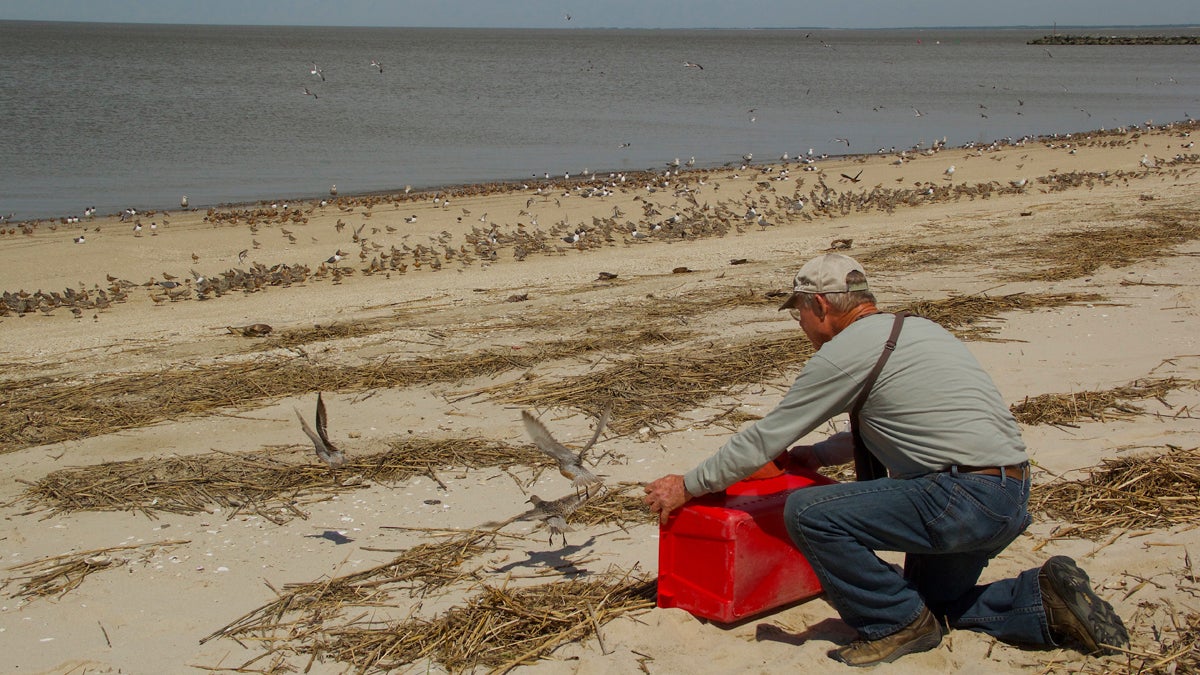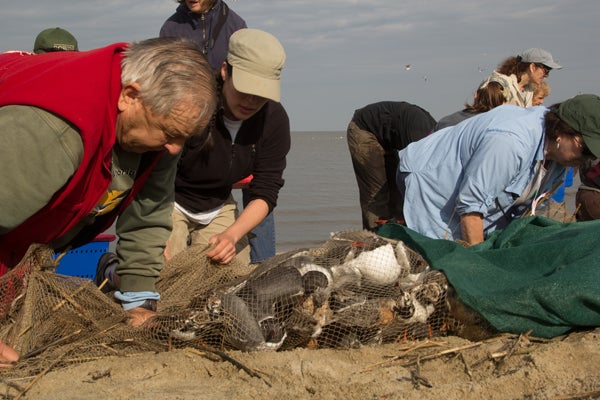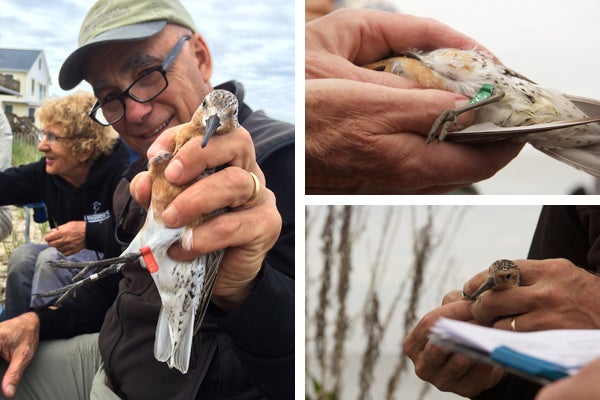Endangered bird has more to fear than a changing climate
Listen
A researcher at a Delaware Bay beach tags rufa red knots. (Katya Gorker/for WHYY)
A rapidly changing planet landed the little rufa red knot on the threatened species list, but its obstacles to survival aren’t limited to the temperature of the planet.
It’s shorebird season in the Delaware Bay, and thousands of red knots, ruddy turnstones and sanderlings fight for space with laughing gulls on the shore of north Reeds Beach in Cape May, New Jersey. They’re all feasting on horseshoe crab eggs, the house specialty.
And the birds have an audience at breakfast this morning. A team of experts from Canada, England, New Zealand, and the U.S. are here to catch and measure the remarkable Rufa red knot—a bird the size of an iPhone 6 with a red-cinnamon chest—that travels every winter from the Canadian Arctic to Tierra del Fuego, the farthest tip of South America, and then back again in Spring, stopping on the Delaware Bay each way.
Amanda Dey, principal zoologist for the New Jersey Department of Environmental Protection, says they know from geolocators they’ve been installing on the birds that they don’t stop flying for days.
“We know how long they’re in the air, when they stopped, how long they stopped for, so you can see an actual years worth of travel distances,” said Dey. “And you can see some of their birds who were in the air for 6 days or in the air for 8 days coming straight from Argentina to the Delaware Bay, I mean it’s crazy, totally crazy.”
On the beach, some of the researchers begin assembling a 25-yard long net. Larry Niles, a wildlife biologist that’s been leading the Delaware Bay Shorebird Project for over 20 years, prepares three cannons that will propel the net over the birds.
“The whole sort of game of cannon-netting is you’re trying to get the net come out really fast, because the birds can react in a split second, and if the net goes off too slowly, then it will kill birds because they’ll rise up in front of the net and they’ll get hit by the net,” said Niles, who collaborates with the American Littoral Society and the Conserve Wildlife Foundation.
By 7:45 in the morning, the net has been set, and everything is ready to go. As soon as 200 birds wander into Larry’s line of fire, he will activate the net cannon. Later, they will separate them by species and measure them.
“What do you think Humphrey? I think we got it,” says Niles.
“I think we have a reasonable catch,” says Humphrey Sitters, a biologist from the UK, who has been studying and following shorebirds for 15 years.
“3-2-1 fire!” shouts Niles and the cannon shoots the net, capturing more than 300 birds.

Researchers tend to the birds caught in the net. (Katya Gorker/for WHYY)
At first sight, the rufa red knot is not a spectacular bird. What makes the bird special to scientists and birders around the world is the mythology around its epic migration.
“I mean they’re the sort of the rock stars of the bird world,” said Sitters. “They’re great travelers, but they don’t have passports. They don’t belong to any country; they’re everybody’s birds because they migrate to and they visit so many different places.”
The rufas arrive in Jersey, hungry and tired. To get here they’ve burned through their body weight, including stomach muscles, and the only food they can digest are soft, pin-head sized, horseshoe crab eggs. The problem is that there’s not enough of them. So only 50 percent of the red knots get back to an ideal weight for their flight to the Arctic, where they breed.
Rufa red knots went from 80,000 in 1980s to just 12,000 in 2005, because of horseshoe crab overfishing. And in the last decade, the changing weather has been making their situation worse by messing up their finely tuned biological clock.
“As the waters warm through climate change the crabs might come to shore earlier and if the birds are not arriving earlier, the eggs they need won’t be there. Is like showing up at the restaurant after it closes,” said Charles Duncan, an independent conservation biologist who lead the Manomet’s Shorebird Recovery Project for ten years.
Experts agree having the rufa listed as a “threatened species” in the Endangered Species Act in 2014 helped secure federal funding to restore beaches where horseshoe crabs lay their eggs. But the Rufa’s food supply is still at risk.
It turns out that horseshoe crab blood’s key component, lysate, is used to detect bacterial toxins in every injectable solution or implantable medical device that enters our body. For that reason, every year, the biomedical industry catches 600,000 crabs and collects a third of their blood—each gallon is worth $60,000—and although they release them alive. Studies estimate that between 10 and 30 percent of them die and many of those remaining can’t mate again.
And if all these wasn’t enough, scientists also worry that the rising trend of oyster farming in South New Jersey will challenge the ability of the crabs to get to the beach and lay their eggs.
“So, climate change continues to be a threat, but that immediate overharvesting of horseshoe crabs, in my mind and in the minds of most scientists, is the single driver,” said Duncan.
So, what would happen if there were no more Rufa red knots? Would the rest of the ecosystem collapse?
“I don’t think we can make that claim,” Duncan replied. “But it sure will be a less rich world that we would be passing on to our children, and their children, if we didn’t have birds that connects us. A school kid in Tierra del Fuego can see the same bird that a school kid here in Delaware, and the same thing that a member of the First Nations in Ontario. That, to me, is a powerful thing. And that is something that it would be heartbreaking to lose.”
Rufa red knots usually stay in Delaware Bay until the first week of June, but Celebrate Delaware Bay organizes horseshoe crab tagging and surveys with the community during all the month. The best spots for bird watching are Fortescue or North Reeds Beach, in New Jersey. Visitors can get close to the birds without crossing the restricted access boundaries.
Note: This article has been edited two clarify two points: the rufa red knot was listed as “threatened” not “endangered” in 2014, and the bird also stops more than once on its epic migration.

The Rufa red knot is a bird about the size of an iPhone 6 with a red-cinnamon chest (Katya Gorker/for WHYY)
WHYY is your source for fact-based, in-depth journalism and information. As a nonprofit organization, we rely on financial support from readers like you. Please give today.



